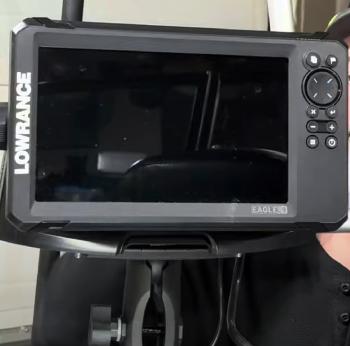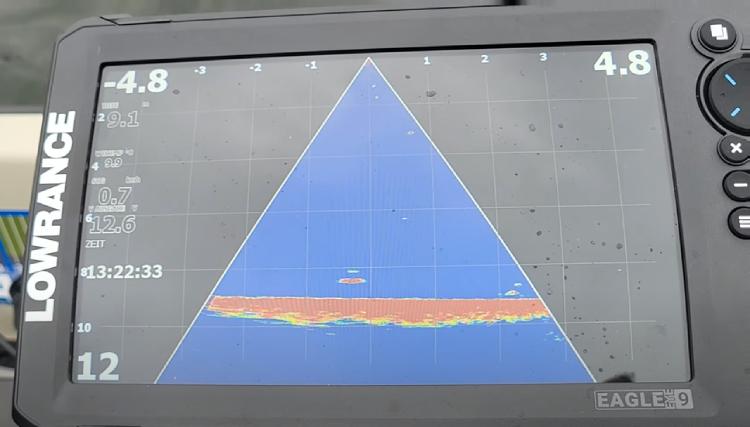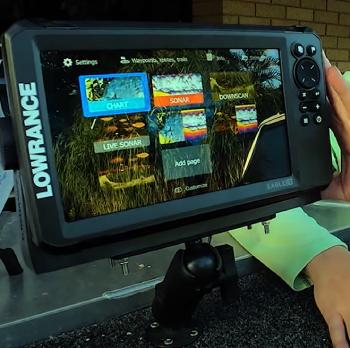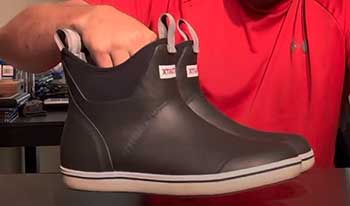Listen, if you’re an angler like me who’s been eyeing a fish finder that won’t drain your bank account but still delivers the goods, let me tell you—the Lowrance Eagle Eye 9 is calling your name.
I’ve been out on the water with this beauty, and it’s a game-changer at a price that doesn’t make you wince. Packed with live sonar, a crisp screen, and mapping that keeps you on fish, it’s the kind of tool that makes you wonder why you didn’t buy it sooner.
Trust me, you need this on your boat—grab it before your fishing buddy does!
My First Waves With The Eagle Eye 9

I’ll never forget the first time I fired up the Lowrance Eagle Eye 9 on my little bass boat.
It was a crisp Saturday morning, the kind where the lake’s still as glass and you can hear the fish plotting their next move.
I’d just installed it the night before—honestly, it took me about 30 minutes tops, thanks to that slick twist-lock connector.
No swearing at complicated wiring, no calling a buddy for help. Just plug it in, mount the transducer, and go.
Out on the water, I flipped it on, and the 9-inch IPS screen lit up like a dream.
Even with the sun blazing down, I could see every detail—no squinting required, even through my polarized shades.
I started with the forward live sonar because, let’s be real, watching fish react to my lure in real time is the stuff fishing fantasies are made of. I cast toward the bank, and there it was—my lure swimming back toward me on the screen, clear as day.
Then, boom, a shadow darted in. I paused the lure, watched that fish nose up to it, and set the hook. Landed a chunky largemouth that I’d have buzzed right past without this thing.
Later, I switched to the down live mode since we were hovering over a 25-foot drop-off. It took me a minute to tweak the depth settings—okay, maybe an hour to really get the hang of what I was seeing—but once I did, it was like having x-ray vision underwater.
Fish showed up as distinct blips, not just fuzzy blobs, and I could tell exactly where they were hanging out. The CHIRP sonar kicked in too, giving me a sharp view of the bottom and those sneaky fish hugging it.
By the end of the day, I was hooked—pun intended—on this unit. It’s not perfect (more on that later), but for my first dance with live sonar, it felt like I’d cracked the code to the lake.
What’s So Great About the Eagle Eye 9?

- Crystal-Clear Screen That Pops
Let’s talk about that IPS screen first because, wow, it’s a standout. I’ve used other fish finders where you’re tilting your head like a confused puppy just to see the display in daylight. Not here. The 9-inch screen is big enough to feel luxurious but not so huge it crowds my boat.
Whether I’m standing at the bow or leaning back at the console, the viewing angle holds up, and the clarity is unreal. Small fish, big fish, underwater brush—it all shows up sharp and vivid. You’ll feel like you’re staring into an aquarium.
- Live Sonar That Brings the Action to You
The live sonar is where this unit flexes its muscles. With forward and down views, I can watch fish move in real time, and it’s a total adrenaline rush. The forward mode is my go-to—I cast out, reel in, and see fish darting toward my lure like I’m directing a movie.
It’s not just cool; it’s practical. I’ve caught fish pausing my bait at just the right moment because I could see their reaction. The autotuning feature helps too—it adjusts on the fly so I’m not fiddling with settings all day. For under a grand, this kind of tech feels like stealing.
- Easy Installation for Non-Techies Like Me
I’m no electrician, and I bet you’re not either. That’s why the Eagle Eye 9’s setup is a breath of fresh air. The twist-lock connector snaps in like it’s meant to be, and there’s no bulky module to wrestle with.
I had it mounted on a homemade transducer pole (more on that later) in half an hour, and I was ready to roll. If you’re upgrading from an older unit or starting fresh, you won’t be stuck scratching your head—this thing’s built for folks who just want to fish, not tinker.
- Mapping That Keeps You in the Game
The C-MAP charts with Genesis Live are a solid perk. I’m not saying they’re perfect—sometimes the accuracy’s a bit off—but having detailed maps of over 17,000 U.S. lakes preloaded is a lifesaver.
I’ve used it to scout new spots and even create custom half-foot contour maps on the fly. It’s like having a cheat sheet for finding fish-holding structure. You won’t get lost, and you’ll spend less time wandering around aimlessly.
- Budget-Friendly Bang for Your Buck
Here’s the kicker: this whole package—live sonar, CHIRP, DownScan, mapping, and a killer screen—comes in at about a third of what you’d pay for high-end units. I shelled out $999, and it felt like I’d scored a deal.
For entry-level anglers or anyone who doesn’t want to remortgage their house for tech, this is your ticket. You’re getting pro-level features without the pro-level price tag.
The Downsides: What’s Not So Hot?
- Narrow Down Sonar Cone

Alright, let’s keep it real—the down live sonar isn’t my favorite.
The cone angle feels tight, like I’m peeking through a keyhole instead of getting the full picture.
When I’m fishing deeper water, say 20 to 35 feet, I want to see more of what’s below me, not just a narrow slice.
It works fine for spotting fish directly under the boat, but if they’re off to the side, I’m out of luck.
I’ve heard some folks wish it had a wider sweep too, and I’m right there with them.
- Mapping Could Use a Tune-Up
The C-MAP charts are handy, but don’t expect perfection. I’ve noticed some spots where the contours don’t quite match reality—like a hump that’s deeper than it says or a drop-off that’s off by a few feet.
It’s not a dealbreaker, especially if you’re using this more for sonar than navigation, but if you’re a mapping junkie, you might grumble. The Genesis Live feature helps fix this over time, but it’s not instant.
- No Side Imaging, No Touchscreen
Here’s a bummer for some: no side imaging. If you’re used to seeing what’s off to the left and right of your boat, you’ll miss it here. The Eagle Eye 9 sticks to forward and down views, which I’m cool with, but it’s worth knowing.
Also, the screen isn’t touchscreen. I didn’t mind navigating with buttons—it’s straightforward enough—but if you’re spoiled by swiping on your phone, it might feel old-school.
- Takes Time to Master the Display
If you’re new to live sonar like I was, expect a bit of a ramp-up. The first few hours, I stared at the screen wondering, “Is that a fish or a stick?” It’s not hard, just different.
You’ll need to play with depth and sensitivity to get it dialed in. Once you do, it’s smooth sailing, but don’t expect to be a pro right out of the box.
Keeping Lowrance Eagle Eye 9 Running: Maintenance Tips
- Protect That Transducer
The transducer’s your golden goose, so treat it right. I built a separate pole mount instead of sticking it on my trolling motor—keeps it steady and out of harm’s way. After every trip, I rinse it off with freshwater, especially if I’ve been in murky or salty stuff.
Mud and gunk can mess with the signal, and you don’t want that. When I’m hauling the boat, I tuck the transducer up or remove it entirely—road vibrations can loosen things up over time.
- Clean the Screen Like It’s Your Phone
That gorgeous IPS screen deserves some love. I wipe it down with a microfiber cloth after each outing—no harsh chemicals, just a damp cloth if it’s grimy. Sunscreen smudges and fish slime don’t stand a chance.
I also keep it covered when not in use—Lowrance sells a protective cover, and it’s worth it to dodge scratches or UV damage. You’ll thank me when it still looks brand-new next season.
- Check Connections Regularly
The twist-lock connector is a champ, but don’t get lazy. Every few trips, I give it a quick once-over to make sure it’s snug. Water and jiggling can loosen things up, and the last thing you want is a flickering screen mid-cast.
I also peek at the power cables for wear—frayed wires are a buzzkill. A little attention here keeps it humming along.
- Update the Software When You Can
Lowrance pushes software updates, and they’re not just fluff—they can tweak performance or fix bugs. I pop an SD card in the slot (it’s got one built-in, thank goodness) and check for updates every couple of months.
It’s a five-minute job, and I’ve noticed smoother sonar after the last one. Don’t sleep on this—it’s like giving your unit a little tune-up.
- Store It Smart
When the season’s done or I’m not fishing for a while, I don’t just leave it on the boat. I bring the Eagle Eye 9 inside—dry, cool, and away from humidity. The transducer comes off too, stored flat so it doesn’t bend or crack.
You’re investing in this thing, so don’t let it rot in a damp garage. A little care now means it’s ready to roll when you are.
How Lowrance Eagle Eye 9 Stacks Up Against the Competition?
- Garmin’s LiveScope Line
Garmin’s LiveScope is the big dog in live sonar, and I’ve seen it in action—those images are razor-sharp, and the coverage is wild with forward, down, and even perspective modes. The Eagle Eye 9 doesn’t try to outmuscle it; it’s leaner, with just forward and down views.
Where Garmin’s transducer sweeps a broader area, my Lowrance feels more focused—great for targeting specific fish but less for scanning wide open water. Price-wise, though, Garmin’s a wallet-buster at two or three times the cost.
For me, the Eagle Eye 9’s simplicity and price tag win out over Garmin’s bells and whistles.
- Humminbird’s MEGA Live
Humminbird’s MEGA Live is another heavy hitter I’ve compared notes on with buddies. It’s got stunning clarity and side imaging, which the Eagle Eye 9 skips. I’ll admit, seeing fish off to the sides is tempting, especially in shallow cover.
But Humminbird’s setup is pricier and more complex—extra modules, more wiring. My Lowrance keeps it stupid-simple with one transducer, no fuss. If you’re all about max detail and don’t mind the cost, Humminbird might edge it out, but I’m happy with my budget-friendly clarity.
- Raymarine’s Element Series
Raymarine’s Element series is more of a traditional sonar player, with CHIRP and DownVision but no live sonar like the Eagle Eye 9. I’ve tinkered with an Element at a friend’s place—it’s solid for structure mapping, and the interface is slick.
But without that real-time fish-chasing thrill, it feels like a step back. The Eagle Eye 9’s live views give me an edge Raymarine can’t touch, though its mapping might be a hair more polished. For me, live sonar trumps static scans every time.
Frequently Asked Questions (FAQ)
Yep, it sure does! The Eagle Eye 9 comes with a built-in chartplotter loaded with C-MAP charts and Genesis Live. I’ve used it to map out lakes and find hotspots—it’s not flawless, but it’s plenty useful for keeping you on track.
Nope, no side imaging here. It’s all about forward and down views with this unit. I don’t miss it much since the live sonar keeps me locked on fish ahead and below, but if you love seeing side-to-side, you’ll need to look elsewhere.
Lowrance backs this bad boy with a one-year warranty. I haven’t had to test it yet—mine’s been rock-solid—but it’s nice knowing there’s a safety net if something goes wonky within that first year.
Battery life depends on your setup since it runs off your boat’s power. I’ve got mine hooked to a 12V battery, and it sips juice—Lowrance says max draw is 2.9A at 13V with full sonar and backlight. I’ve fished all day without a hiccup, so you’re good as long as your battery’s charged.
Conclusion: Get The Eagle Eye 9 And Fish Smarter
After weeks of splashing around with the Lowrance Eagle Eye 9, I’m sold—it’s a steal for what it delivers. The live sonar, clear screen, and easy setup make it a no-brainer for anyone who wants to up their fishing game without breaking the bank.
Sure, it’s got quirks, but the pros far outweigh them. You deserve a tool that puts fish in the boat, not stress in your life. So, do yourself a favor—buy this unit, hit the water, and watch your catch rate soar!

